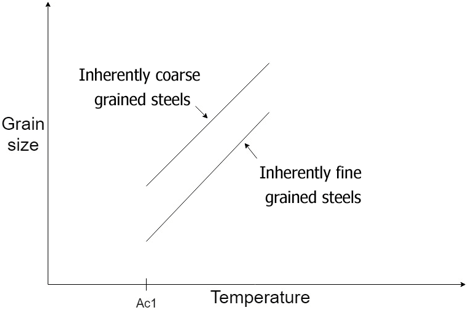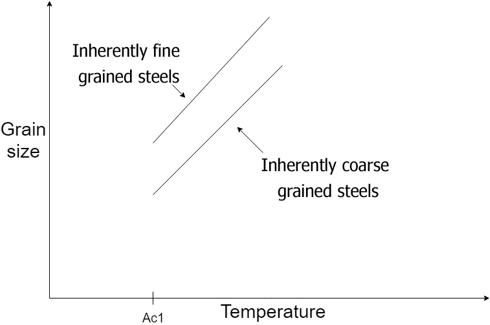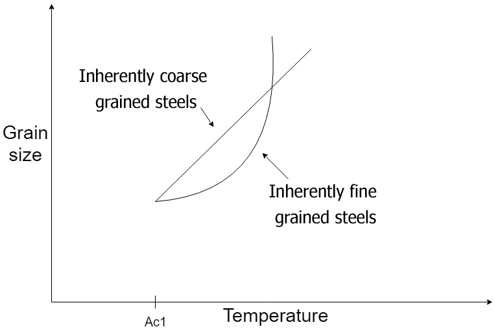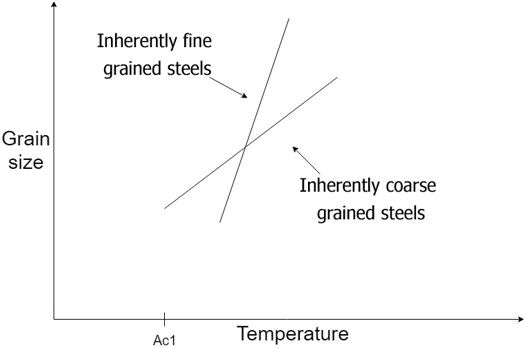This set of Heat Treatment of Metals and Alloys Multiple Choice Questions & Answers (MCQs) focuses on “Steels – Austenitic Grain Size”.
1. Which of the following statements are correct for inherently fine grained steels?
a) They resist the austenitic growth with increasing temperature
b) They support the austenitic growth with increasing temperature
c) Kinetics of the austenitic growth is very fast
d) They do not remain fine after 900°c
View Answer
Explanation: As the name suggests, the inherently fine grained steels resist the growth of austenite grains with temperature. Therefore as the temperature increases, the austenite grains do not grow initially. The kinetics of growth is very slow. The austenite grains remain fine at temperatures up to 1050°c.
2. Which of the following diagrams correctly depict the nature of austenite grain growth for inherently fine grained steels and inherently coarse grained steels?
a)

b)

c)

d)

View Answer
Explanation: Inherently fine grained steels resist the growth of austenite grains with increase in temperature initially up to 1050°c. After that the austenite grains increase in size abruptly. In inherently coarse grained steels the austenitic grains grow abruptly with temperature.
3. Which of the following statements is correct for austenite?
a) The process of growth and nucleation takes place simultaneously
b) The process of growth takes place before nucleation
c) The process of growth takes place after nucleation
d) The process of nucleation and growth are independent of each other
View Answer
Explanation: Once the steel is heated above eutectoid temperature, nucleation of austenite begins. The process of growth also takes place simultaneously with nucleation till all the ferrite and cementite transform to austenite.
4. Which of the following statements is correct about the actual austenitic grain size?
a) It is independent of temperature and holding time
b) It depends on the temperature up to which the steel is heated but is independent of holding time
c) It depends on both the temperature up to which the steel is heated and on the holding time
d) It only depends on the holding time and not on the temperature up to which the steel is heated
View Answer
Explanation: In practical scenario, the steel is heated above the eutectoid temperature. This is done so as to ensure complete homogenization of austenite and considerable growth of original austenite. This homogenization and growth depends on both the temperature and holding time.
5. What is the role of ultramicroscopic oxides, carbides and nitrides on austenitic grain growth?
a) They promote austenitic grain growth
b) They prevent austenitic grain growth
c) They have no role to play in grain growth
d) Ultramicroscopic oxides, carbides and nitrides are not present in austenitic grains of inherently fine grained steels
View Answer
Explanation: In inherently fine grained steels, it is the presence of ultramicroscopic oxides, carbides and nitrides which prevent the austenitic grain growth. These ultramicroscopic particles are not present in inherently coarse grained steel that is why they grow abruptly with rise in temperature.
6. Which of the following statements is incorrect for ultramicroscopic oxides, carbides and nitrides?
a) They are refractory in nature
b) They can withstand high temperatures
c) They are not present at grain boundaries
d) They prevent austenitic grain growth
View Answer
Explanation: Ultramicroscopic oxides, carbides and nitrides are refractory in nature. It means that they can withstand high temperatures. It is the presence of ultramicroscopic oxides, carbides and nitrides which prevent the austenitic grain growth in inherently fine grained steels. They are present at grain boundaries of austenite.
7. Which of the following statements are correct for steels which are treated with vanadium, boron and titanium?
a) They are inherently fine grained steels
b) They are inherently coarse grained steels
c) Ultramicroscopic oxides, carbides and nitrides are not present in such steels
d) No such variety of steels exist which can be treated with vanadium, boron and titanium
View Answer
Explanation: Boron, titanium and vanadium are carbide and nitride forming elements. We know that ultramicroscopic oxides, carbides and nitrides are present in inherently fine grained steels. Therefore the steels which are treated with vanadium, boron and titanium are inherently fine grained steels.
8. Why does the grain size of inherently fine grained steels become bigger than inherently coarse grained steels after a certain temperature?
a) Because of dissolution ultramicroscopic oxides, carbides and nitrides
b) Because of breakage of ultramicroscopic oxides, carbides and nitrides
c) Because of increase in number of ultramicroscopic oxides, carbides and nitrides
d) Inherently fine grained steels can never have greater grain size than inherently coarse grained steels
View Answer
Explanation: Because of ultramicroscopic oxides, carbides and nitrides, the increase in grain size is restricted. But after a certain temperature, these ultrafine particles dissolve in the matrix. Therefore there is more restriction on the growth and it surpasses inherently coarse grained steel steels.
Sanfoundry Global Education & Learning Series – Heat Treatment of Metals and Alloys.
To practice all areas of Heat Treatment of Metals and Alloys, here is complete set of Multiple Choice Questions and Answers.
If you find a mistake in question / option / answer, kindly take a screenshot and email to [email protected]
